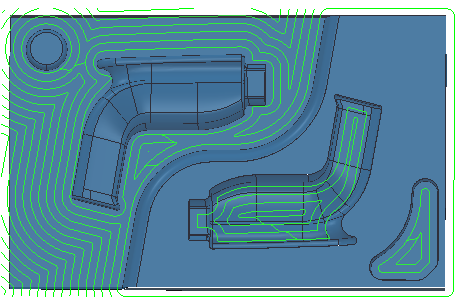Use the Model Area Clearance strategy to rapidly remove excess material from the stock and keep air moves to a minimum. Offset toolpaths work well in the bottom of pockets whereas raster toolpaths are often used on open parts. Offset area clearance is good for high speed machining. High speed machining provides a consistent tool loading at the expense of an increased number of rapid, air moves across the component. This minimises wear to both the tooling and machine. Vortex machining enables you to increase the feed rate whilst maintaining surface quality and tool life.

There are several pages associated with the Model Area Clearance strategy:
- Model area clearance — The main page used to choose the area clearance styles and associated settings.
- Raster — Settings to define a raster area clearance style. This page is available when you select a Style of Raster on the main page.
- Offset — Settings to define offset area clearance styles. This page is available when you select a Style of Offset model or Offset all on the main page.
- Vortex — Settings to define a Vortex area clearance style. This page is available when you select a Style of Vortex on the main page.
- Step cutting — Settings to define in-line rest roughing. This minimises terracing when creating area clearance toolpaths with a large stepdown. This is available when you select a Stepdown of Automatic.
- Wall finishing — Settings to perform a Final Stepover which is different from the normal stepover.
- Unsafe segment removal — Settings to remove small toolpath segments.
- Flat machining — Settings to machine flat areas on the model.
- High speed — Settings for the smoothing options to avoid sharp changes in tool direction when high speed machining.
- Order — Settings to control the order of machining.
- Approach — Settings to control how the tool approaches the path.
- Automatic verification — Settings to automatically verify toolpaths on creation.
The remaining pages are common toolpath strategy pages.